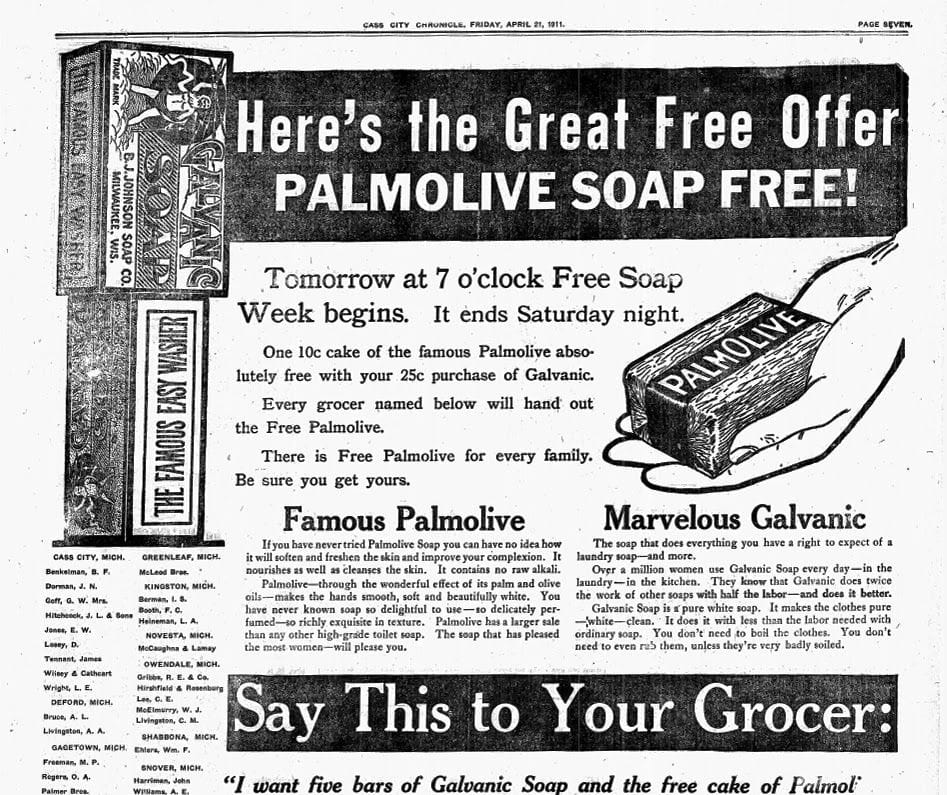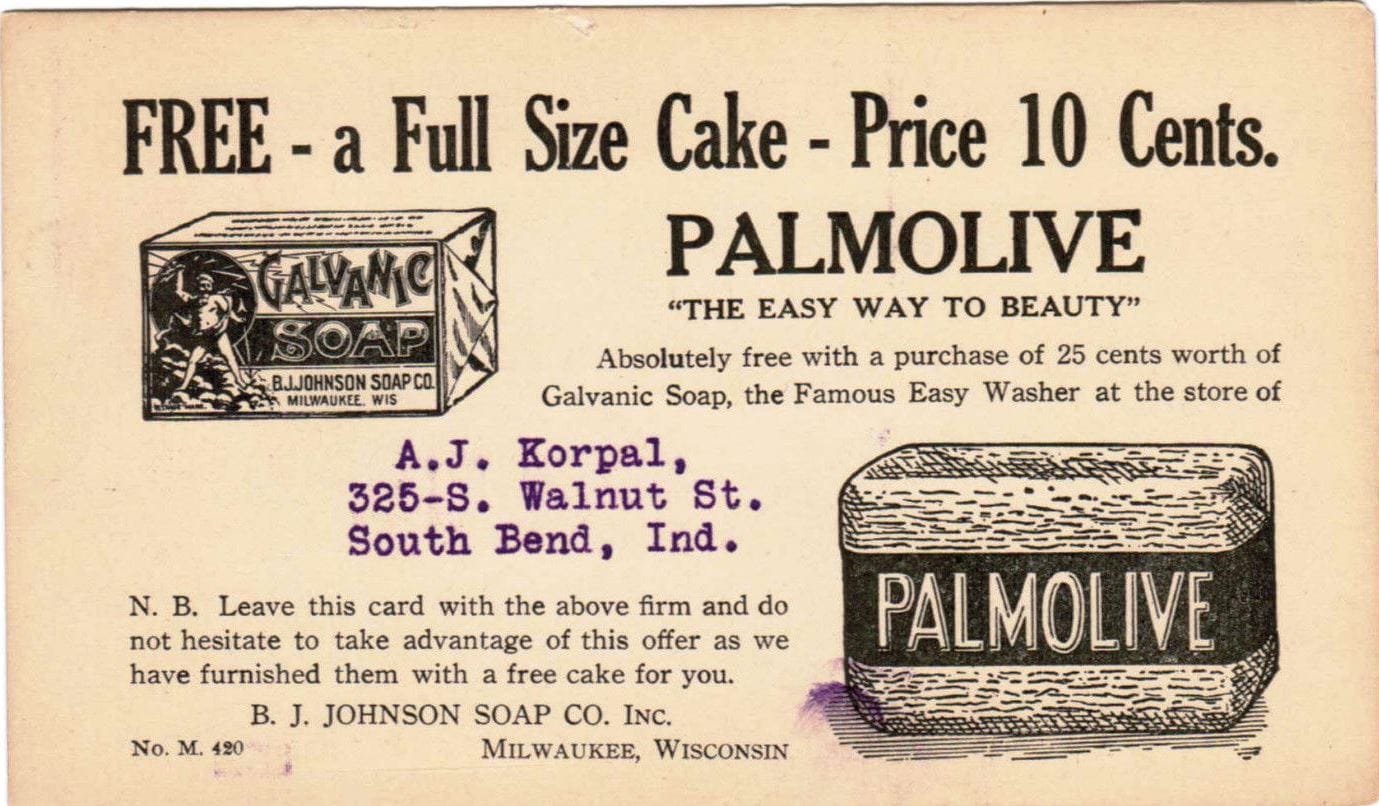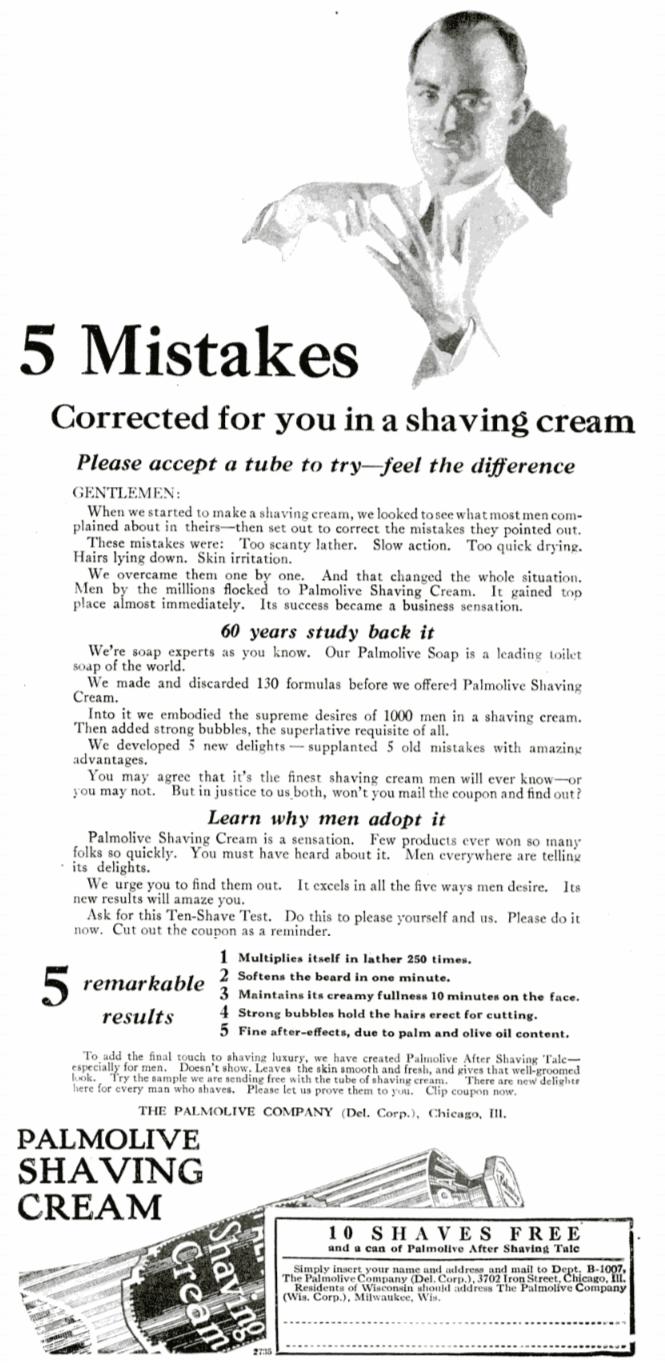Long-Lasting Lessons from Claude Hopkins Most Successful Advertising Campaigns (PART III)
Palmolive Soap and Shaving Cream Campaigns
From one Milwaukee product to another. Last week was “The beer that made Milwaukee famous,” today we’ll see the strategy behind one of Milwaukee’s most famous native products, Palmolive soap.
B.J. Johnson Soap Co. introduced Palmolive Soap in 1898. In the beginning, they didn't consider advertising it because they already had a soap in the market, Galvanic Soap, that was selling well. But a visit to Claude's agency changed that.
He saw potential in the light green bar made with palm and olive oils. He was right. By the early 1900s, Palmolive was the world’s best-selling soap.
The success of that campaign led to advertising another Palmolive product, shaving cream.
Let’s see how he approached both advertising campaigns.
Advertising Project - Palmolive Soap
Strategy
Test your product's appeal with a small campaign. If the test is positive, go bigger.
The Product
Palmolive soap, a light green toilet soap made of palm and olive oils.
Campaign Approach
Introduce a new product to a market with a small test campaign.
According to Claude Hopkins, the Palmolive soap campaign started in 1911 with a budget of $700. The first step, test the beauty appeal.
To do that, they ran two or three ads in local newspapers. The ads told the story of Palmolive soap, emphasizing its beauty appeal. At the top of the ads, they made an announcement: in the upcoming days, they would buy a bar of Palmolive soap for every woman showing interest.
It created curiosity, expectation, and fear of missing out.

Seeing interest, Claude wrote then a page ad with a coupon. The coupon authorized the dealer to deliver one bar of Palmolive to the person presenting it and charge the company 10 cents for it.
Several thousands of women tried the product thanks to that campaing.
Since the first ads confirmed the effectiveness of the beauty appeal, they successfully ran the same campaign in other cities. By the end, they had spent about $50,000 on local advertising. The final step was national distribution with ads including a coupon valid at any drug store in the country.

Lessons learned from the Palmolive soap campaign
- Not sure about your product’s appeal? Test it. A small test campaign can save you a lot of money in the long run. If the test fails, try a different appeal. Go local, then national, or worldwide.
- Before launching a new product, make sure there’s interest in it. A big launch doesn't make sense if nobody wants your product.
- Give samples only to those requesting them. If you want people to appreciate your product, don’t give samples to everyone and everywhere.
- To introduce a new product to the market, they force distribution. Following this strategy, you don’t have to sell the product twice (dealer and consumer). You sell the product to the consumer, and the dealer will supply the demand. You don't need a salesperson. The dealer must stock the product you are offering because, if not, he risks losing the sale since the coupons are valid at any store.
Advertising Project - Palmolive Shaving Cream
Strategy
Market research to know what the consumers want.
The Product
Palmolive Shaving Cream.
Campaign Approach
Make customers switch brands by giving them what they want.
When every man already uses a shaving cream, how do you make them switch brands?
You ask them what they want and give it to them.
That's what Claude Hopkins did. His team interviewed hundreds of men to know what they desired in a shaving cream. Analyzing their research data, they discovered that men wanted these three things in a shaving cream:
- Abundant lather.
- Quick action.
- Enduring lather.
Claude went to Palmolive lab chemists and asked for these three things. The chemists made it happen. From that moment, these were the claims made in every ad:
- Abundant lather. Chemists proved Palmolive Shaving Cream multiplied itself in lather 250 times.
- Quick action. Chemists proved that with Palmolive Shaving Cream the beard absorbed 15 percent of water within one minute, making the hair wax-like for cutting.
- Enduring lather. Palmolive Shaving Cream maintained its creamy fullness for ten minutes on the face.
Palmolive Shaving Cream was the first to distribute the results of the tests. Every claim they made had a test result backing it up.
And, of course, the ads had a coupon to try the product for free.

Lessons Learned from Palmolive shaving cream
- In high-competitive markets, don’t advertise with “Buy my product.”Do your research. Listen to your customers and make a product that fulfills their needs and desires. Give people reasons to switch brands.
VOC research can help you with that. Use online message mining, on-site and email surveys, and one-on-one interviews to identify your customers pains, desires, and needs. You can also find out what features they like and dislike. - Use facts and figures to back up every claim. It increases credibility and trustworthiness. Facts and figures make your copy more specific. The more specific your copy, the clearer your message.
- It's a classic example of using "mistakes" in your copy to grab the reader's attention and present your product as the solution. Other brands are making these mistakes. Your brand doesn't. You position your brand as the one correcting other brand's mistakes.
- Take advantage of product differentiation. Make sure your reader understands why your product is unique and better than its competitors.
Here is the complete Claude Hopkins successful campaigns series:
- Long-Lasting Lessons from Claude Hopkins Most Successful Advertising Campaigns (Part I) - The Cotosuet Campaign
- Long-Lasting Lessons from Claude Hopkins Most Successful Advertising Campaigns (Part II) - The Schlitz Beer campaign
- Long-Lasting Lessons from Claude Hopkins Most Successful Advertising Campaigns (PART III) - Palmolive Soap and Shaving Cream Campaigns
- Long-Lasting Lessons from Claude Hopkins Most Successful Advertising Campaigns (PART IV) - The Puffed Cereals Campaign
- Long-Lasting Lessons from Claude Hopkins Most Successful Advertising Campaigns (PART V) - The Pepsodent Toothpaste Campaign
